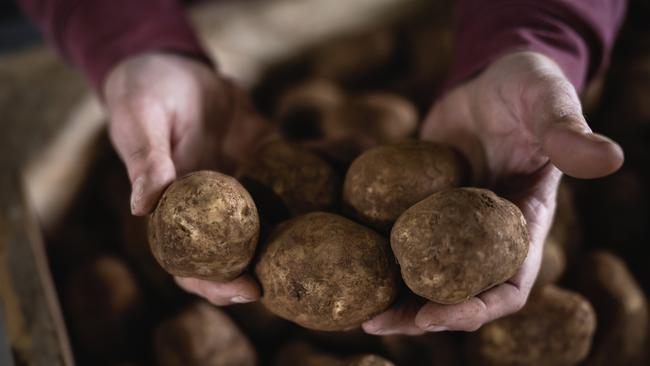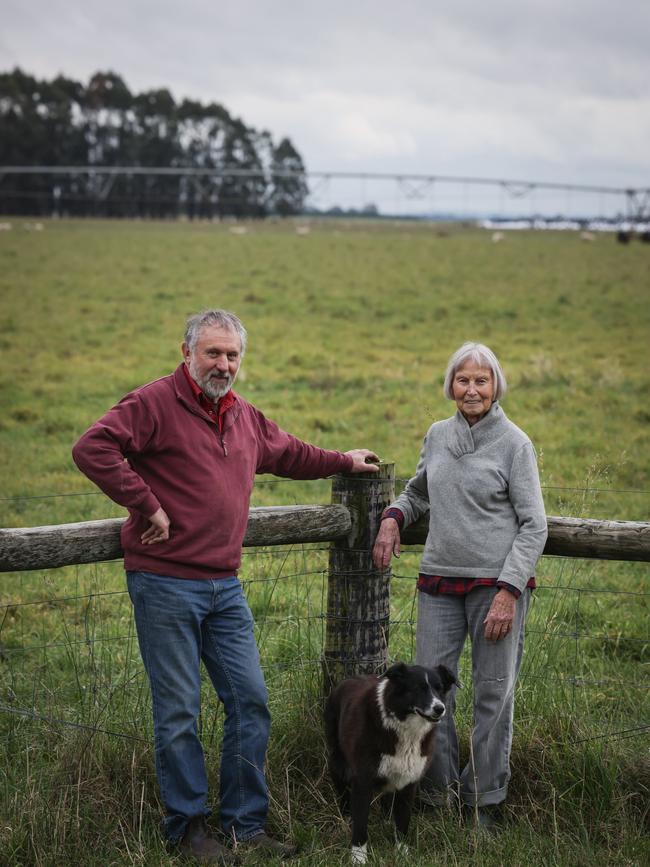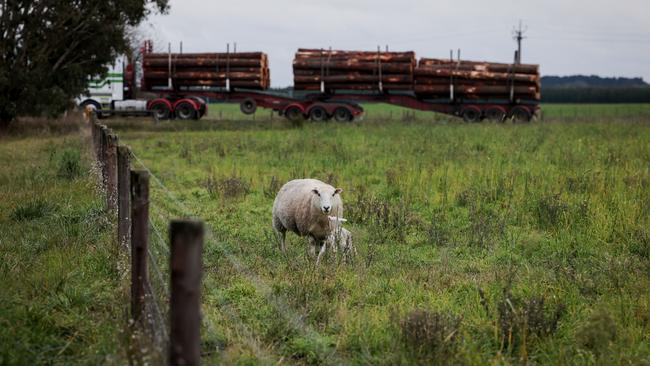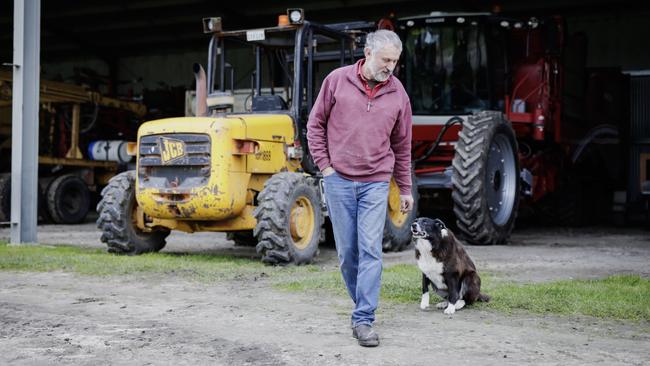Buckley Farms: How Mt Gambier potato growers increased output 15-fold
The latest Dutch tech and a shed full of modified machines have helped a Mt Gambier potato family boost harvest volumes 15-fold.
Small potatoes to big business has been the growth trajectory for South Australian farmer Terry Buckley and his family.
The fifth-generation spud grower, working with partner Jackie, parents Fay and Jeffrey, and brother Wayne have transformed their enterprise to build a potato powerhouse that pumps out more than 24,000 tonnes of spuds a year grown across 445 hectares at Pleasant Park in South Australia’s southeast.
With a laser-sharp focus on soil health, the Buckleys optimise yields using every tool at their disposal. That includes a huge workshop of bespoke machinery, a state-of-the-art Dutch storage system and planting design that makes best use of every drop of water and fertiliser.
The result has been nothing short of amazing.
Harvest volume have increased by a staggering 15 times over the past four decades, soil structure has been transformed and biodiversity is thriving on the previously developed property.

“When we first came here, my mother used to cut all the seed spuds with her hand machine,” Terry said. “We used to plough the land with our little Fergie tractor starting in the middle of winter. Then we’d take the whole of October and into November planting these spuds.
“Now, provided we’ve done the initial land work … what was the season’s work when we first came to Mount Gambier, we now get that done by three in the afternoon.
“Technology moves on, and it is just fabulous really.”

MOVE WITH THE TIMES
The Buckleys grow varieties including caribou and innovator for French fries, lamoka for wedges, and rumba, lamoka and propriety varieties for crisps, supplying Smiths Chips, McCain Foods and UniGrain. They also grow seed potatoes mostly for their own use.
Their land is managed on a five-year rotation, carrying sheep, pasture and then potatoes to keep soil disease-free and maximise organic matter.
Less than a generation ago, however, things were much different.
The family and young Terry, then 7, were growing spuds across just seven hectares on a modest 46ha farm at Lobethal in the Adelaide Hills, where they also ran a dairy.
“Obviously on a rotation, you can’t grow many potatoes,” Terry said. “And my father wasn’t interested in anything that didn’t have an engine in it, so the cows had to go.
“My mother was running the sheep, but the scale just wasn’t there. So in 1966 we chose to leave that farm and we bought a soldier-settler farm down here.”
The purchase – their 271ha property 28km northeast of Mt Gambier – turned out to be “really a poor choice” for potatoes, due to its soil.

“It is too wet and too risky and has shallow clay under soil,” Terry said. “But you can only buy what is for sale.”
The farm had a 100mm top layer of grey sand on top of 400-500mm of coarse white beach sand, then a thick layer of impervious clay. The combination had little water-holding capacity, but also caused waterlogging in places.
In a particularly bad year in the late 1970s, when Terry had just finished school, they managed to harvest just 900 tonnes of spuds from a 40a planting on the property. And after grading, only had 400 tonnes to sell.
The disaster took years to recover from. Terry’s interest in improving both the microbiology and soil structure underground began in the ’80s after having trouble with the soil on what is now Terry’s 190ha home farm and was previously a potato farm.
They spent years reading and studying, and finished up changing their approach to tillage and nutrition. They also implemented the five-year rotation, acquired more land in the region and honed in on soil nutrition and aeration.
Thanks to their hard work, coloured soil now makes up the top 250-300mm on the home property, and the white sand is now grey.
“Now, 45 years on, we grow 1100 acres (445ha) of spuds,” Terry said.
“We get around 23-24,000 tonnes of potatoes a year. We now plant nearly 2000 tonnes of seed spuds, which is more than we actually used to harvest in the old days.
“I never thought it was going to be like this when I left school really. I remember saying to the (McCain) field officer, ‘look I don’t ever think we’ll get past 3000 contracted tonnes’, and now we’re at 23,000 spread across three different customers.”

Alongside the potato operation, the family also runs 10,000 crossbred self-replacing Lambpro ewes. Fay, 85, is in charge of the sheep operation.
“She has been buying the best lamb rams from Lambpro for some years now. They are pretty fancy sheep,” Terry said.
Primeline ewes are mated to Primeline rams to produce ewe lambs for sale and continue the flock. Ewe hoggets are mated to Dorset rams for their first year and then are bred with the Primeline rams, while the wether portion is sold over the hooks for prime lamb meat.

TECHNICALLY SPEAKING
Making positive change hasn’t all been smooth sailing.
Terry said they have made mistakes and about 30 years ago that due to poor soil health that caused their crop quality to drop so low, McCain stopped taking their potatoes from Terry’s home farm.
“We were on this farm (using) four-year rotation, loved ploughing, too much ground work, didn’t grow enough grass between each rotation,” Terry said. “We finished up with what you call poor soil structure, and ended up with all the potato diseases – the nematodes, the pink soft rot, the verticillium wilt.
“So we’ve changed our soil management, particularly nutrient ratios. We don’t cultivate as much as we used to by a long, long way. We still use a rotary hoe but we run it very shallow just to chop the tops out of the pasture.
“You rely on the root systems, when you do rip it up, to actually sit against each other to make lumps and bumps. Lumps and bumps are your friends because that’s where the air gets through.
“We’ve learnt, and worked on from there.”

Investing in advanced technology – and building their own – has been part of the secret to their success.
Terry and his 93-year-old father, Jeffrey, have both always modified machinery. While Terry focuses on sorting and grading equipment, Jeffrey’s specialty is harvesters.
“Back in the Adelaide Hills, he was probably one of the first people to have anything to do with bulk-handling of potatoes,” Terry said. “He actually built in his lifetime six potato harvesters. We still use the newest one.
“I don’t think we own a machine that we haven’t modified … to the point where we had a brand spanking new (harvester) out of Germany and … when the man came out from Germany to get it going, we were already into the front of it with the oxy torch changing it. He wasn’t happy.”
Every innovation is all to do with the soil.
“A lot of the time farmers have been let down by engineers,” Terry said. “Machinery is just bits of steel. You don’t change the growing style to suit the machinery, you’ve got to chop it all up ’til it works the way you want it to work.”
CLOSE THE GAP
One important change has been narrowing row spacings to better use water and fertiliser. This was made possible by Jeffrey’s bespoke harvester.
Bucking the global trend to increase row intervals – sometimes up to 100cm in the US to accommodate modern machinery – the family set rows just 50cm apart.
“I could never see the point in that (increasing spacing),” Terry said, “because you have a furrow that’s 30cm wide.
“Nothing good happens in there. You’re spreading your fertiliser around, and it rolls down the bottom. We tend to have non-wetting sand, so the water sheds off the rows down to the bottom as well. It’s there with the fertiliser and if there’s not root structure under there, it is gone.”
With closer rows, roots reach across the furrow, keeping soil loose and friable.
Minimal, but targeted tillage has also allowed roots to push deeper in the soil and extract more water.
Jackie is in charge of nutrients and fertilisers, with regular soil tests informing application rates. She is also chief tractor operator and inter-row cultivator, because “she’s the best driver”, and uses her water divining skills to find locations for all their bores.
“Her understanding of soils is amazing,” Terry said.

They have also changed irrigation to centre pivots, and are working on implementing variable rate delivery.
Now, they produce more tubers per hectare while still achieving good quality and size at harvest, which runs from February to mid-May.
“As a result of what we’ve done, we grow our potatoes now with basically no insecticides. Even with seed potatoes … which is basically unheard of,” Terry said.
Currently they are making chaser bins to run after harvesters and a grader that is more portable than conventional machines.
Terry has also recently installed a Dutch-designed Tolsma potato storage system, which has been a game-changer.
“We spent a million dollars, but you get your seed physiologically younger,” he said. “I always heard that it was important but didn’t realise just how important.”
The way potatoes are aged during their dormancy period directly affects how they perform once planted. Temperature, air flow, humidity, carbon dioxide levels all affect the tuber’s eventual yield and health once in the ground.
The hi-tech storage uses a unique ventilation system to create the ideal climate for potatoes.
“Once we sorted out the store, then the potatoes wanted to grow and we got benefit out of all the other things we had done. Like changing the rows.
“It’s been the best thing we ever did.”




